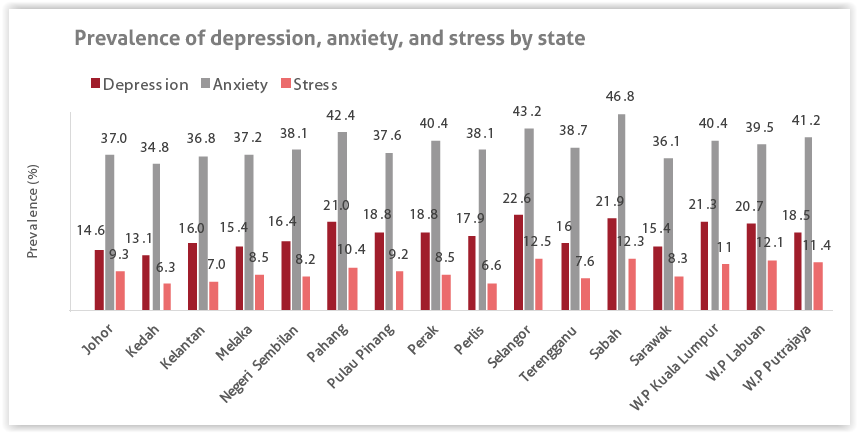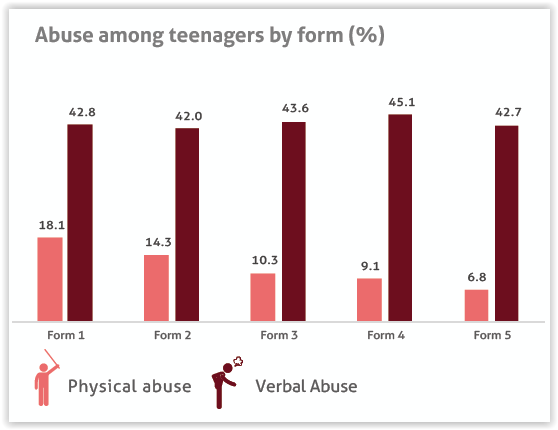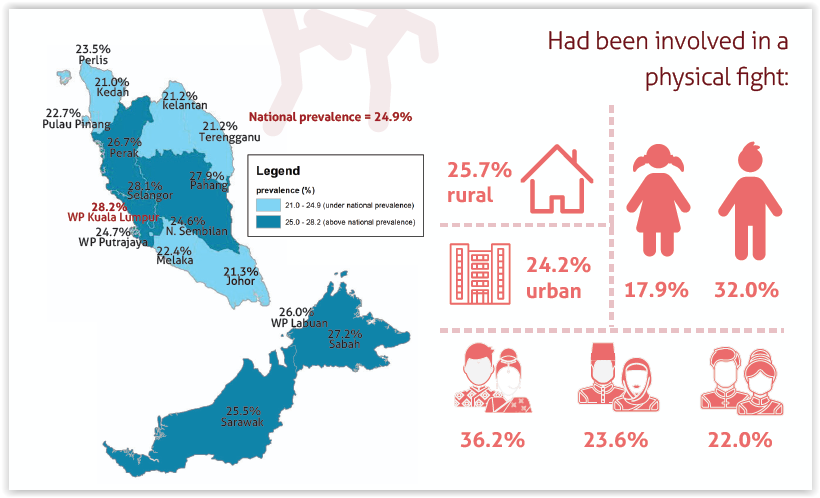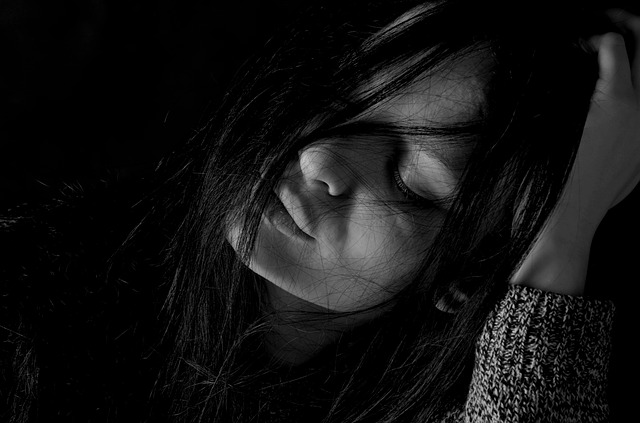KUALA LUMPUR, Nov 20 — Suicidal behaviour has risen among Malaysian adolescents, with 10 per cent of 13-year-olds having tried to kill themselves, according to a newly released Ministry of Health (MOH) survey.
The National Health and Morbidity Survey (NHMS) 2017: Key Findings from the Adolescent Health and Nutrition Surveys found that suicidal ideation among Malaysian teens increased from 7.9 per cent in 2012 to 10 per cent in 2017. Suicidal plans similarly rose from 6.4 per cent to 7.3 per cent in the same period, while suicidal attempts increased from 6.8 per cent to 6.9 per cent.
According to the survey on Malaysian secondary school students, suicidal behaviour was highest among 13-year-old Form 1 students, with suicidal ideation at 11.2 per cent, suicidal attempts (10.1 per cent), and suicidal plans (9 per cent).

Teenage girls suffered higher rates of suicidal behaviours than boys, reporting suicidal ideation at 10.8 per cent compared to boys’ 9.1 per cent. More girls also planned suicide, at 7.8 per cent, compared to 6.8 per cent of boys. But slightly more boys engaged in suicidal attempts at 7 per cent, compared to girls at 6.9 per cent.
Suicidal ideation was highest in Kuala Lumpur at 13.2 per cent, while suicidal planning and suicidal attempts were highest in Selangor and Perak respectively at 9.5 per cent and 9.3 per cent.
Ethnic Indian adolescents reported the highest suicidal tendencies in double digits, with suicidal ideation at 19.3 per cent, suicidal plans (17 per cent), and suicidal attempts (17.9 per cent).
Ethnic Chinese teens also recorded double-digit suicidal behaviour, reporting suicidal ideation at 13.7 per cent, suicidal plans (10.1 per cent), and suicidal attempts (10.7 per cent).
Malay adolescents reported suicidal ideation at 7.8 per cent, followed by suicidal plans and attempts at 5.4 per cent and 4.6 per cent respectively.
For Bumiputera Sarawak teens, suicidal ideation was reported at 10.8 per cent, suicidal planning (7.4 per cent), and suicidal attempts (9.4 per cent). Among Bumiputera Sabah secondary school students, 10.1 per cent reported suicidal ideation, 7.5 per cent suicidal planning, and 6.1 per cent suicidal attempts.
Suicidal ideation and planning were higher in urban areas at 10.9 per cent and 7.9 per cent respectively, compared to rural places at 8.8 per cent and 6.6 per cent respectively. But teens living in villages engaged in higher suicide attempts at 7.2 per cent, compared to those residing in cities at 6.7 per cent.
Ethnic Indian Teens Have Poorest Mental Health

One in five of Malaysian adolescents suffered from depression, according to the NHMS, while 40 per cent and 10 per cent were anxious and stressed respectively.
Teenage girls suffered from anxiety more than boys at 42.3 per cent, compared to boys’ 37.1 per cent. But slightly more teenage boys suffered from depression at 18.9 per cent, compared to girls at 17.7 per cent. Girls were also slightly more stressed at 10.3 per cent than boys at 8.9 per cent.
Sabahan adolescents reported the highest anxiety levels in Malaysia at 46.8 per cent, while teens in Selangor experienced the highest depression rate and stress levels at 22.6 per cent and 12.5 per cent respectively.
Ethnic Indian adolescents reported the highest rates of depression (33 per cent), anxiety (47 per cent), and stress (15 per cent), compared to other ethnic groups in Malaysia. Forty-seven per cent of Bumiputera Sabah teens also reported anxiety.
Bullying Most Common Among 13-Year-Olds

One in six, or about 17 per cent, of Malaysian adolescents said they were a recent victim of bullying, defined as being on the receiving end of “bad and unpleasant” actions, such as “teasing a lot in an unpleasant way”, or being “left out of things on purpose”.
More boys complained about being bullied than girls, at 19 per cent of boys compared to 14 per cent of girls, most frequently among Malaysians of Indian ethnicity.
According to the NHMS, Pahang recorded the highest prevalence of being bullied at least once in the past 30 days among Malaysian secondary school students at 22 per cent, while Kelantan recorded the lowest prevalence at 12.5 per cent.
Bullying was reported most frequently by 13-year-old Form 1 students at 23 per cent, decreasing with age to 19 per cent of Form 2 students, Form 3 (15 per cent), Form 4 (13 per cent), and Form 5 (10 per cent).
The most common form of bullying, the NHMS reported, was “being made fun of how body or face looks” at 16 per cent.
Almost Half Of Teens Verbally Abused At Home

One in 10 Malaysian teenagers complained about physical abuse at home, while 40 per cent of adolescents reported verbal abuse.
According to the NHMS, boys highlighted physical abuse at home more than girls at 13 per cent, compared to 11 per cent of girls. But almost half of teenage girls, or 49 per cent, complained about verbal abuse at home, compared to 37 per cent of boys.
The incidence of physical abuse at home reduced with age from 18.1 per cent of 13-year-old Form 1 students to 14.3 per cent among Form 2 students, 10.3 per cent (Form 3), 9.1 per cent (Form 4), and 6.8 per cent (Form 5).
But verbal abuse affected almost half of Malaysian secondary school students consistently across age, at 42.8 per cent of Form 1 students, Form 2 (42 per cent), Form 3 (43.6 per cent), Form 4 (45.1 per cent), and Form 5 (42.7 per cent).
Perceived Little Family, Peer Support
According to the NHMS, less than half of Malaysian teens enjoyed peer support at school or believed that their parents knew what they were doing in their free time.
Only one in seven adolescents said their parents checked their homework, while only a third believed that their parents understood their problems.
Quarter of Teens Involved in Physical Attacks And Fights

The NHMS reported a 25.3 per cent national prevalence of physical attacks among Malaysian teenagers, with almost a third of boys, or 31.4 per cent, having been physically attacked compared to 19.3 per cent of girls.
Adolescents living in Kuala Lumpur reported the highest rate of suffering physical attacks at 30 per cent, followed by Putrajaya (28.7 per cent), and Pahang (28.5 per cent).
The national prevalence rate of teens’ involvement in a physical fight was 24.9 per cent, said the NHMS.
Kuala Lumpur recorded the highest prevalence at 28.2 per cent, followed by Selangor (28.1 per cent) and Pahang (27.9 per cent).
Almost a third of teenage boys, or 32 per cent, reported having been in a physical fight, compared to 17.9 per cent of girls.
The NHMS was conducted in 2017 among teens aged 13 to 17 via anonymous questionnaires that were distributed among 30,496 students from 212 randomly selected secondary schools, with an 89.2 per cent response rate.









